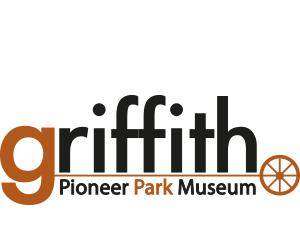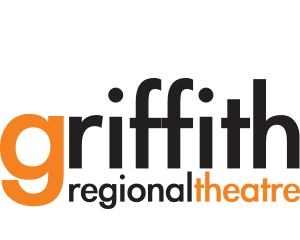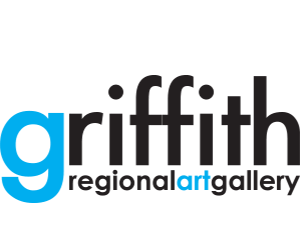Our Buildings
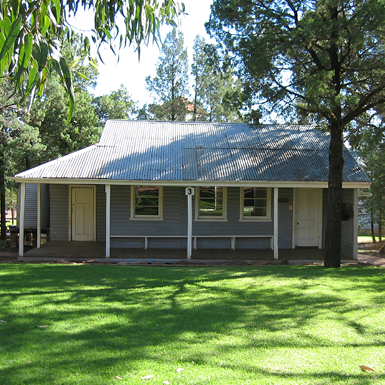
Wumbulgal School
Wumbulgal School is representative of the large number of one-teacher schools on the M.I.A. Before the days of the farm car, it was impossible for families in this closely settled rural area to get their children to town schools. This one room school building was originally built in 1909 at Euroley (sometimes spelt Uroly), situated on the Murrumbidgee River between Narrandera and Yanco, located seven kilometres downstream from Yanco Weir. Constructed from Weatherboard, including floor and verandah on two sides, it consists of one classroom, with a most recent partitioning used as a secure display area, and a small built-in room on one end of the verandah.
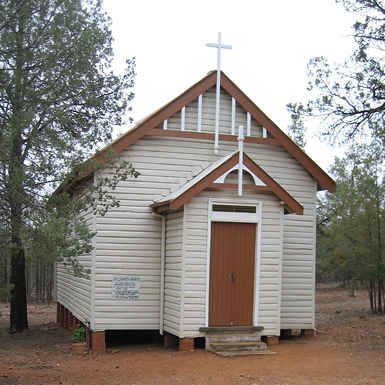
St James Church
St. James Church built in 1907 is the oldest church in the Murrumbidgee Irrigation Area. It was originally located on the north-west side of the Griffith-Yenda road, between Yoogali and Bilbul, on what is now Farm 512, then a property known as "The Cliffs". In 1913, with the establishment of the M.I.A., the Water Commission paid for the removal of the Church to the more populous centre of Jondaryan, or Hanwood, as it is now known, becoming the centre for pioneer irrigation settlers. The Church is still used today for weddings and occasional services.
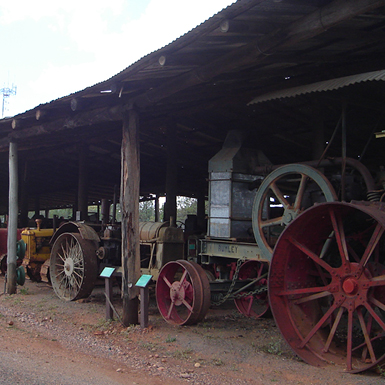
Machinery Shed
The Farm Machinery Shed was built c.1970 by volunteers, and demonstrates the traditional local rural construction method of a cypress pole frame tied with fencing wire and clad with recycled corrugated galvanised iron. The shed holds an assortment of historic tractors, harvesters and other farm machinery equipment. One notable machine is the McCulloch Rice Harvester, which is thought to be the world’s first self-propelled front-cut header/track cutter developed for rice harvesting. It is a forerunner to modern rice harvesters and an improvement on pulled rice harvesters, which were unable to cut the outside 4-6ft of each rice bale.
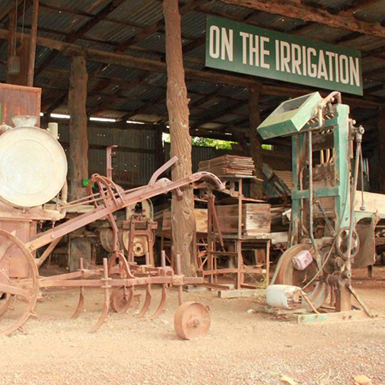
Irrigation Exhibition Shed
The On the Irrigation Exhibition Shed was built c.1970 by volunteers, and demonstrates the traditional local rural construction method of a cypress pole frame tied with fencing wire, clad with recycled corrugated galvanised iron. Some interesting objects within this shed include boxing machines used in the packaging of fruit, a hand-made orange washer, a dehydrator used for drying fruit, a cotton picker and a worldwide patented invention of a carrot washer.
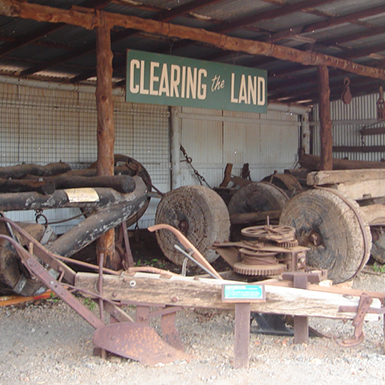
Clearing the Land & Wagon Shed
The Clearing the Land and Wagon Shed was built c.1975 by volunteers, with earth floors, corrugated galvanised iron walls, and a corrugated galvanised iron roof. It demonstrates the traditional local rural construction method of a cypress pole frame tied with fencing wire and clad with recycled corrugated galvanised iron. The shed contains objects used to clear the land of shrubs and trees to make way for irrigation and farming, such as saws, horse and bullock drawn wagons or jinkers, and hames which were attached to the collars worn by horses to pull its load.
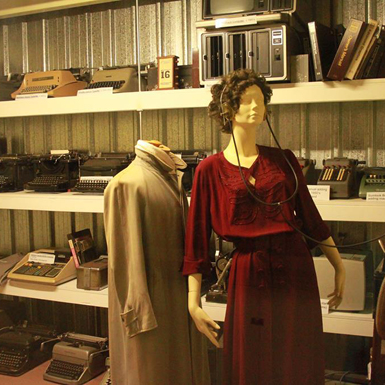
The Collection Management Facility
The Collection Management Facility is a Zincalume clad structure, built in 2005. It holds a number of historic objects and artefacts, which are on display despite this also being a store room. A textile room provides storage for an incredible collection of antique clothing and accessories, including uniforms and army equipment from WWII, and the evening gown worn by Hilda Smith. Other display rooms showcase old prams and bikes, a sizeable collection of matchbox cars collected by Kenneth Ross Kirkman, trophies, clocks, portable wireless radios, gramophones, a Dictaphone, cameras, and crockery to name a few.
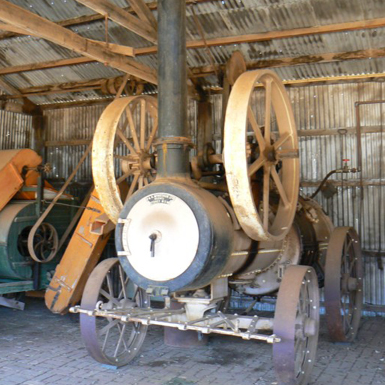
Steam Engine Shed
The Steam Engine Shed was built c.1970 with paved brick & timber boarded floors, corrugated galvanised iron & mesh walls, and a corrugated galvanised iron roof. This shed was opened in 1983 in commemoration of Vern Evans, one of the founding members of Pioneer Park Museum. Vern was responsible for the construction of the steam shed and the installation of much of the equipment. One prominent vehicle in the Steam Engine Shed is the steamroller. This steamroller was used to clear land and form roads throughout the Murrumbidgee Irrigation Area. It belonged to the ‘Wade Shire Council’, now Griffith City Council.
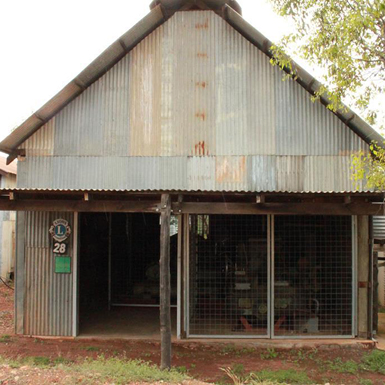
Kooba Generator Shed
The Kooba Generator Shed was built c.1985 with reinforced concrete floors and corrugated galvanised iron walls and roof. The Kooba Generator was made by Grossley Bros Ltd. in Manchester, England. It is a 4 cylinder, 2 stroke, compressed air start, diesel driven generator with 240 HP and 340 RPM. The generator, a marine motor, was purchased by Kooba property owner F.W. Hughes prior to WW1 at a cost of 40 pounds. The main function of the Kooba generator was to pump water for irrigation. The generator transformed power to 80 HP and 60 HP Vickers Gill pumps.
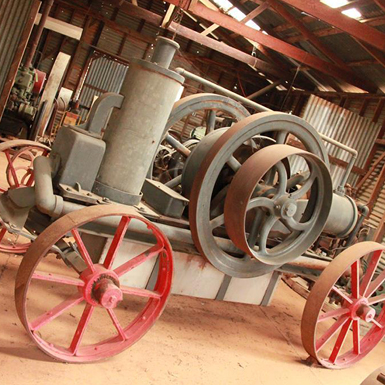
Stationary Engine Shed
The Stationary Engine Shed was built c.1975 by volunteers with reinforced concrete floors and corrugated galvanised iron walls and roof. Stationary engines were widely used for driving pumps, chaff cutters, saw benches, winches, and a variety of farm and industrial machinery where electricity was unavailable or unreliable. They were used extensively on Murrumbidgee Irrigation Area Farms. The outside of this shed also contains a display of Canal Construction equipment, used from 1907 when construction began, to 1913 when water reached Griffith. Scoop gangs dug the canals and channels of the Murrumbidgee Irrigation Scheme using horse-drawn ploughs and scoops.
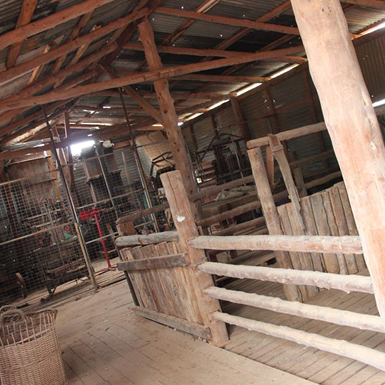
Shearing Shed
According to founder Charlie Sharam's old scrapbooks, the Merriwagga Shearing Shed was built in 1932 as a three stand shed for Alf Baker on "Woodville," Merriwagga, a property near Goolgowi (Carrathool Shire). It was dismantled and donated to Pioneer Park Museum in 1974, where Roy Rathbone, one of the Museum's founders, reassembled it; albeit on a reduced size from the original. The shed is made from timber logs and corrugated galvanised iron walls, corrugated galvanised iron roof, and earth and part timber boarded floors. In 1993 work was done on the shed, including the laying of sleepers in half of the shed to take the weight of the four wool presses, some of which needed extensive reconstruction.
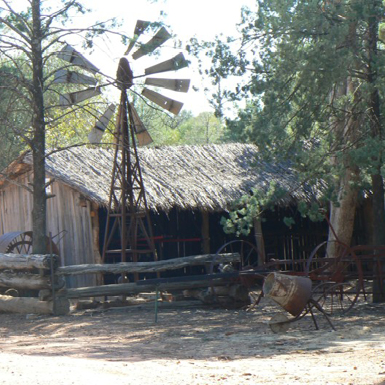
Rathbone Selection
Rathbone Cottage and its outbuildings are a legacy to one of Pioneer Park Museum’s founders, the late Mr. Roy Rathbone. His grandfather William Rathbone built the original cottage on his selection near Echuca in 1872. After the sale of the family farm the cottage and cellar were relocated to the Museum. Shortly afterwards, in 1973, it was destroyed by fire lit by vandals. This present day cottage came from the Carrathool Shire and being the same era as the original Rathbone cottage was donated and then diligently rebuilt by Roy Rathbone, who grew up in the original, using the same materials and design as the original building. The outbuildings are thought to be recreations. The stable has a thatched brush roof, timber walls and dirt floor.
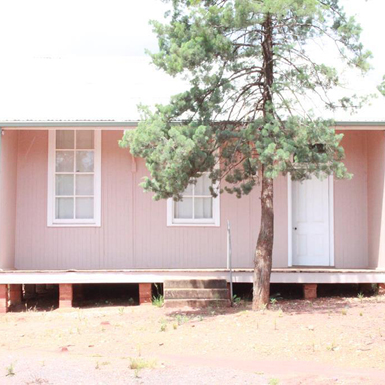
Portable School House / The Knitted Garden
The Portable School House is in original condition, however there is no written record of the history of this building, or even when it was received by the Museum. It is a portable single classroom almost identical to those rooms used at Griffith High School during the mid to late 1930s. The Portable Schoolhouse currently houses the Knitted Garden, a wonderful creative presentation of intricately knitted themed displays and very popular amongst our visitors. It was crafted by Griffith’s “Natty Knittersâ€, a group that encouraged locals young and old to learn and partake in the original art based exhibition.
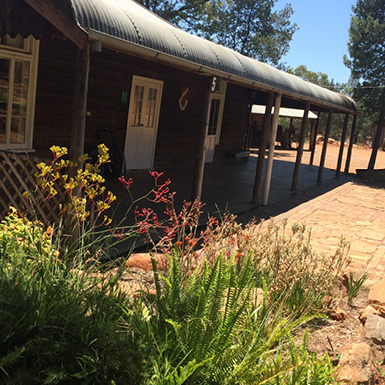
Myall Park Hall
The district of Myall Park is a named locality, which never had official status - no village of that name, no school of that name, no post office, railway station, pub or church. What village there was, was known as Ellimo, for unstated reasons, and when the school gained official status the Department of Education rejected the name "Myall Park" because it was already in use elsewhere in NSW - and the school was named "Climsland". So the hall is the only public building ever to have proudly waved the Myall Park name, and that because it was built by the community itself.
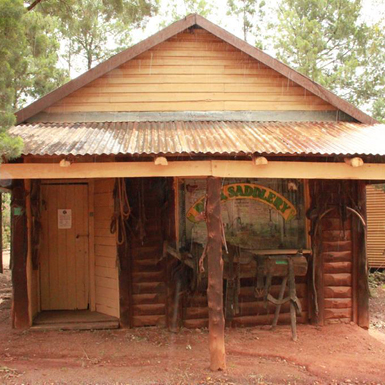
Saddlery
The Saddlery was built by volunteers in c.1970 with timber boarded floors, timber slab walls and corrugated galvanised iron roof. It contains a very fine interior display of a saddlery shop.
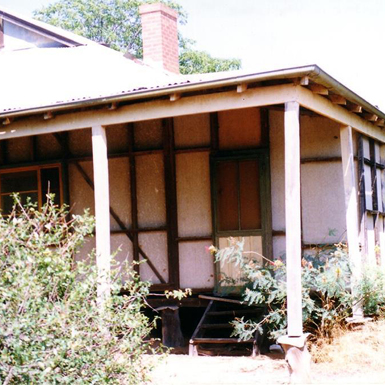
Irrigation House
By the early 1900’s, country houses were increasingly built from mass produced items, including fibro cement and galvanised iron rather than rough-hewn timbers and stone. Fibro cement was very attractive to builders as it was cheap, factory manufactured and was easy to use. From 1920 onwards the Water Conservation and Irrigation Commission encouraged and supervised the construction of standard Commission farm houses for use by new settlers developing the fruit growing region.
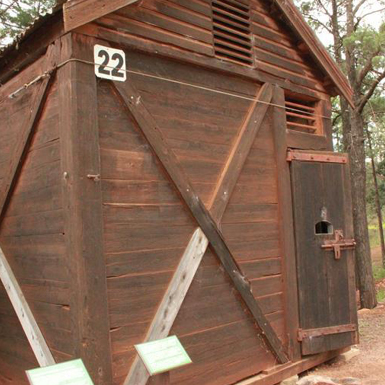
Gunbar Gaol
The Gunbar gaol was known by the NSW Police Department as a 'lock-up' for those prisoners who could not be readily transported to the nearest major gaol. Gunbar Police Station was built in 1901 and consisted of an office, residence, this gaol and stables. The development occurred primarily to assist farmers rid the district of sheep stealing. However, the lock-up was never used as a holding cell for thieves; locals say it was only used a few times to lock up, and settle down rowdy Bushmen after the Gunbar New Year Annual Horse races.
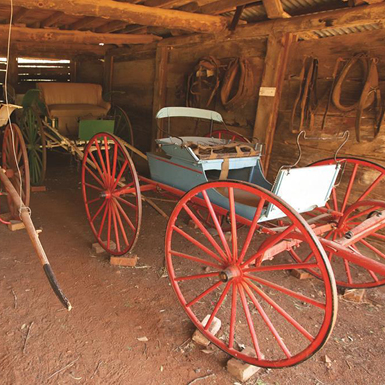
Groongal Coach House
"Groongal†Station was established around 1839, approximately 48km SW of Griffith. By 1865, when it was purchased by three Learmonth brothers, it had an area of 161,880 hectares (400,000 acres), and a 32 km frontage on the Murrumbidgee River. Groongal Coach House is built of massive red gum slabs, and originally had a brick floor. It has a steeply pitched corrugated iron roof, with an attic room underneath, and an annex on one side. According to Robert Merrylees, it was originally double the size, with an attached blacksmith at the back, which had fallen down before the Coach House was relocated to Pioneer Park Museum.
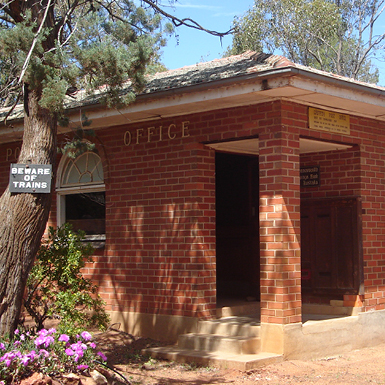
Griffith Post Office
Postal service in Griffith commenced in 1912 in rented premises. The Griffith Post Office was originally built in 1917 and demolished in 1969 to be replaced with a modern building in the same year. The building at Pioneer Park Museum is a recreation as when the original was being demolished the volunteers recovered what they could i.e. signage, the windows, doors and interior fittings. These materials were then placed into storage until a modified version of the Post Office could be reconstructed on site c.1975.
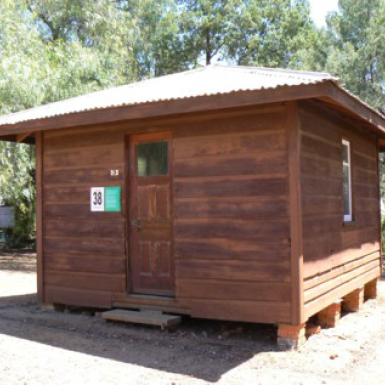
Griffin Sisters Building
This building is thought to be an early 20th century transportable government office. It was possibly a First World War recruitment office in Sydney or a temporary office at Burrinjuck Dam or a Water Conservation and Irrigation Commission office. From around 1918 until 1926 it was the home of Gertrude Griffin, on Farm 223, Yoogali. A veranda was added to provide additional space until a larger home was built in 1926. Gertrude farmed the 15 hectare (38 acre) property in partnership with her sister Audrey. They produced oranges, peaches, apricots, almonds and grapes without fertilisers.
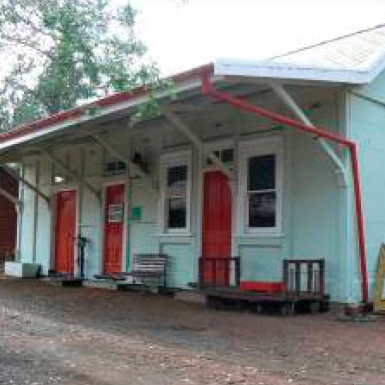
Goolgowi Railway Station
Goolgowi Railway Station was opened in June 1923 as part of the extension of the rail line from Griffith to Hillston. Of the 12 stations established on this track, Goolgowi was the major station, having a crossing loop for trains to pass each other. The station building is constructed of concrete slabs, made with a lightweight product known as 'cindercrete'; a concrete mix using porous coal cinders, recycled from the fire box of steam trains. For isolated regions of NSW this construction method proved to be much cheaper and easier to handle. Goolgowi Station was sited at a point 48km (29 miles) NW of Griffith.
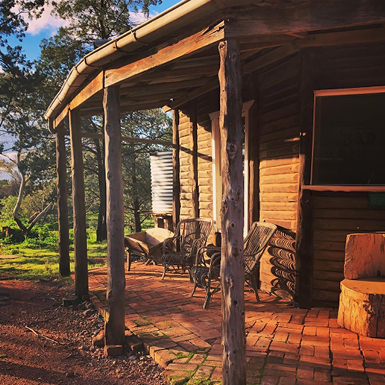
Dumossa Inn
Dumossa Inn is a replica of a typical 20th century hotel. It was designed and built by museum volunteers in c.1970 using recycled timbers from the former Dumossa and Gunbar farm houses.
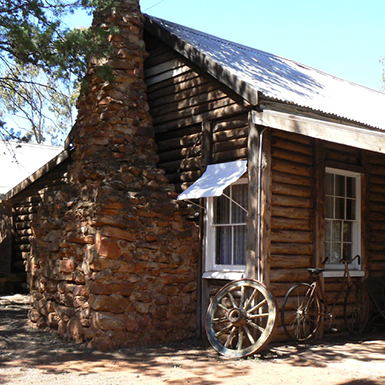
Fairview Homestead
Fairview Homestead was originally built in the Tabbita area, 56km west of Griffith, by English immigrant Alfred Hill. Alfred and his wife Elizabeth arrived to work on Groongal Station around 1870 via Smeaton Station in Victoria. They acquired part of Groongal Station to run sheep around 1880; the land he acquired from Goldsborough Mort and the Joint Stock Bank was originally a grant to Ben Boyd, Whaler from Two Fold Bay. In 1880 Alfred, his elder sons and a carpenter began to build the house. It was called Fairview, because Alfred remarked that the place was so thickly timbered that he could see a "fair view of hard work all his life time".
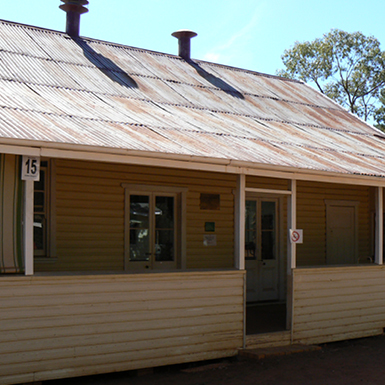
Griffith Hospital
The First Griffith District Hospital, also known as the ‘Commission, Field and Cottage Hospital’ opened in 1922, funded by the community and WC&IC as a result of the Spanish Influenza Epidemic in 1919.It has a capacity for 12 beds inside, plus six on the verandah and a rudimentary operating theatre. This "temporary" hospital remained in use until 1931 when the present hospital opened on the official site in Noorebar Avenue. The old building remained on its original site as rental accommodation until 1977, when it was moved to Pioneer Park Museum, along with its associated Nurses Quarters.
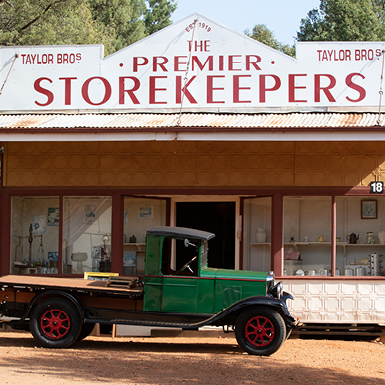
Taylor Bros Store
This was the result of a 1985 Rotary Club project to erect a reconstruction ("replica") of the original 1919 first general store in Griffith, Taylor Bros Store. It is constructed with timber boarded floors, corrugated galvanised iron and weatherboard walls, and a corrugated galvanised iron roof. It was officially opened in the Museum on the 29th March 1988 by Mrs. Fin Taylor.
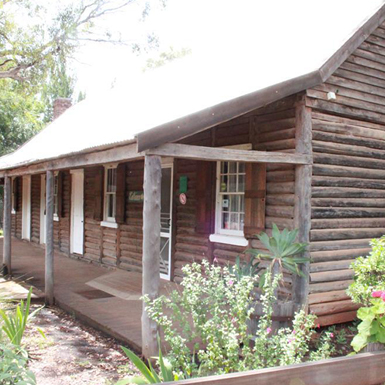
Bynya Homestead
Bynya Homestead is a reminder of the great stations that covered this area in the 19th century. The Station was located to the north of Kooba Station, on which Griffith is now situated, over the Bynya Hills towards the Cocoparras. In its heyday as a sheep run it covered some 170,000 acres, approximately 11 by 25 miles. The name "Bynya", not "Binya", as it was respelt by the Lands Department, meant "mountain". Bynya's history is full of colourful incidents and characters, recorded by the last manager, George Gow. Although not the most prosperous of the stations in the area, it was apparently considered the most likeable, possibly because of its attractive location. Bynya Homestead is now used as the Museum front entrance and gift shop.
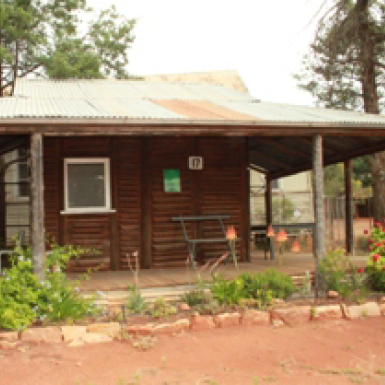
Bromfield's Soldier Settlers Hut
"Bromfield's" Soldier Settler Hut, built in 1919, is an unusual survivor of the post- World War I irrigation pioneering days. This is a substantially modified soldier settler’s hut. Pine logs cleared from the soldier settler block were used to build the very basic one roomed hut. Photographs of the period collected by Griffith's Genealogical and Historical Society show it to have been very similar to other huts built in the Yenda area by young soldier settlers. Extra rooms were later added. It was built on Farm 1485, Yenda, by a young British ex-serviceman, Gerald Debois, who had recently immigrated to Australia.
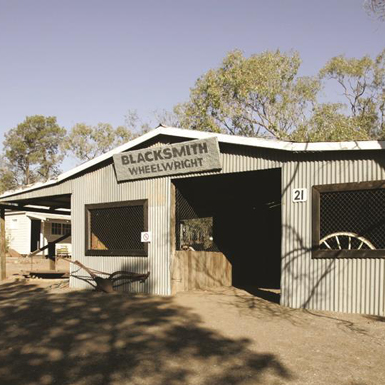
Blacksmith and Wheelwright
The Blacksmith and Wheelwright was built by volunteers in c.1970 with earth floors and corrugated galvanised iron walls and roof. It contains a display of blacksmithing and wheelwright equipment, including a cast iron tireing plate from c.1890-1930.
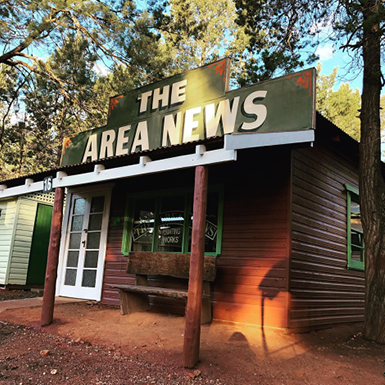
The Area News
The Area News newspaper has been serving the Griffith community and surrounding districts since 1923, the building which served as a newspaper printery, was built by volunteers in c.1970. The aim was to create a small-town newspaper office, complete with printing presses, stationary, printer, guillotine, etc. The Museum had acquired a number of units of a printery previously used by the McCudden Bros, publishers of “The Riverina Advocateâ€, another local Griffith newspaper that was no longer being published. A concrete slab for the building was laid, the heavy machinery was then placed into position, and a weatherboard house structure was built around them.
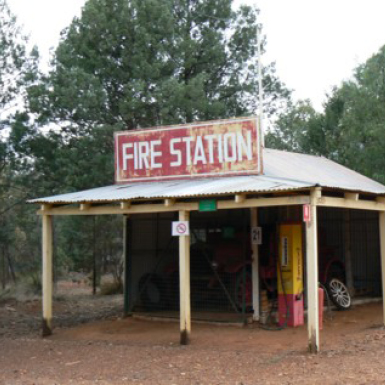
The Fire Station
The Fire Station was built by volunteers in c.1970 with part earth and paved brick floors, corrugated galvanised iron and mesh walls and corrugated galvanised iron roof. The building was reconstructed at the Park and is being maintained by members of the MIA Veteran, Vintage, and Classic Car Club. The building houses a "Dennis" Fire Engine No.81, purchased in 1927 by the NSW Fire Brigade for nine hundred and sixty two pounds, four shillings and fourpence.

